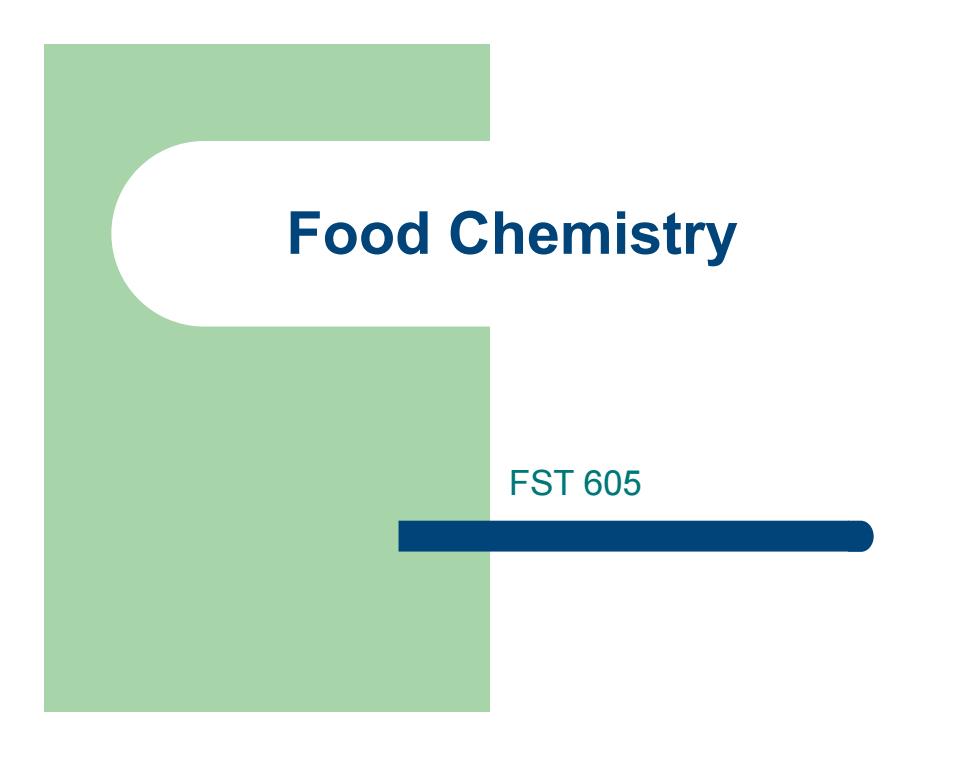
Food Chemistry FST 605
Food Chemistry FST 605
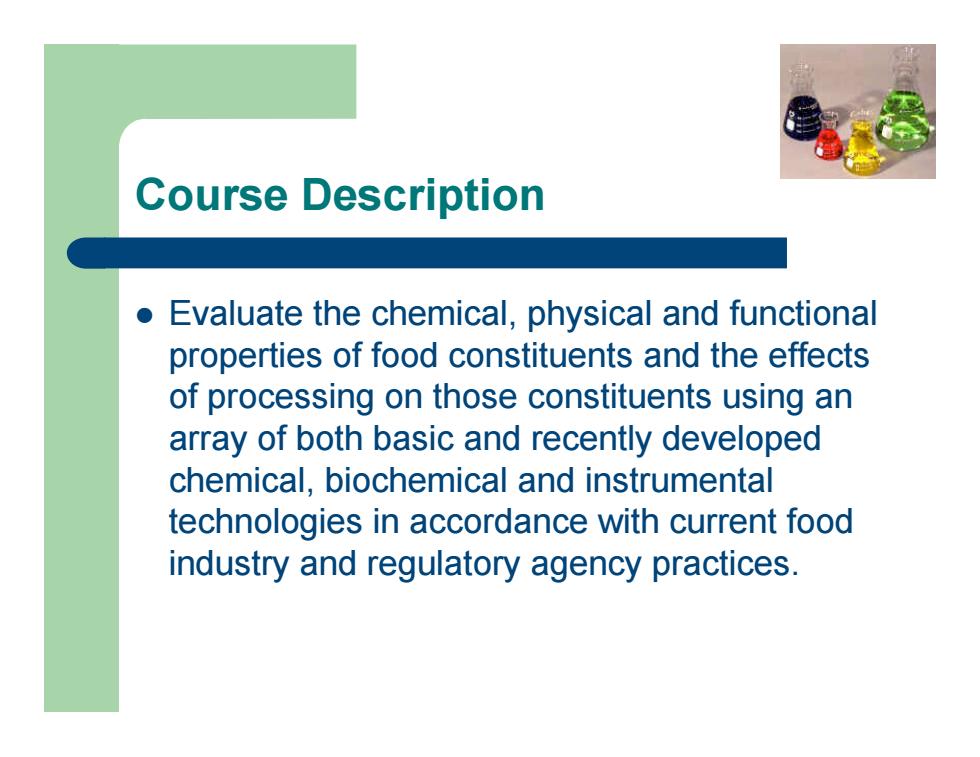
Course Description l Evaluate the chemical, physical and functional properties of food constituents and the effects of processing on those constituents using an array of both basic and recently developed chemical, biochemical and instrumental technologies in accordance with current food industry and regulatory agency practices
Course Description l Evaluate the chemical, physical and functional properties of food constituents and the effects of processing on those constituents using an array of both basic and recently developed chemical, biochemical and instrumental technologies in accordance with current food industry and regulatory agency practices
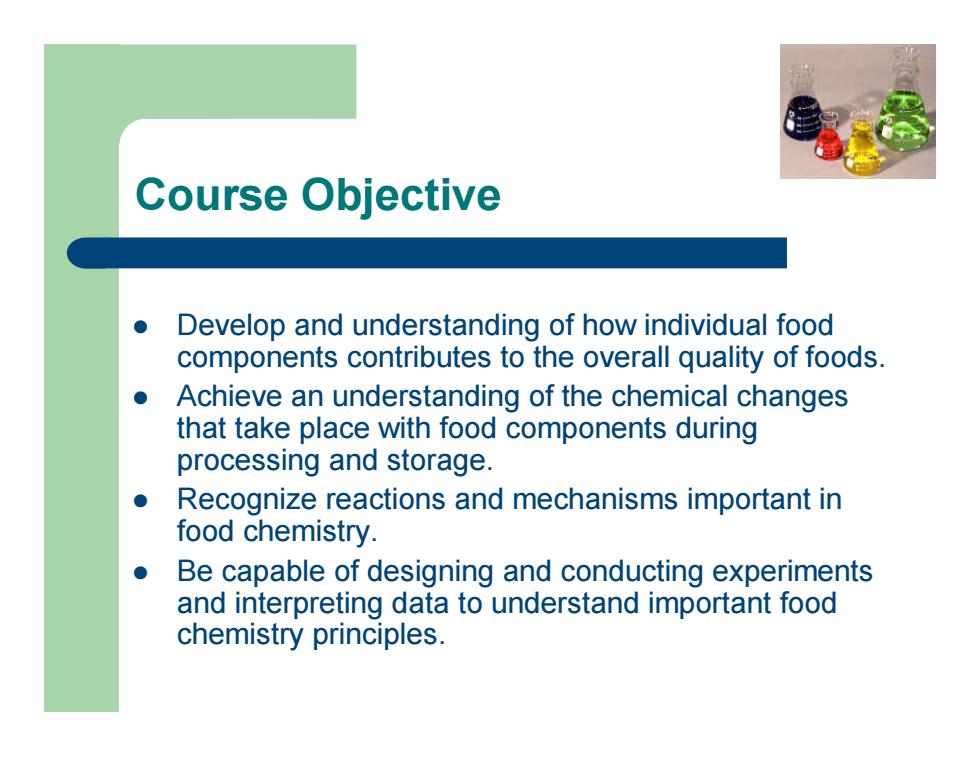
Course Objective l Develop and understanding of how individual food components contributes to the overall quality of foods. l Achieve an understanding of the chemical changes that take place with food components during processing and storage. l Recognize reactions and mechanisms important in food chemistry. l Be capable of designing and conducting experiments and interpreting data to understand important food chemistry principles
Course Objective l Develop and understanding of how individual food components contributes to the overall quality of foods. l Achieve an understanding of the chemical changes that take place with food components during processing and storage. l Recognize reactions and mechanisms important in food chemistry. l Be capable of designing and conducting experiments and interpreting data to understand important food chemistry principles
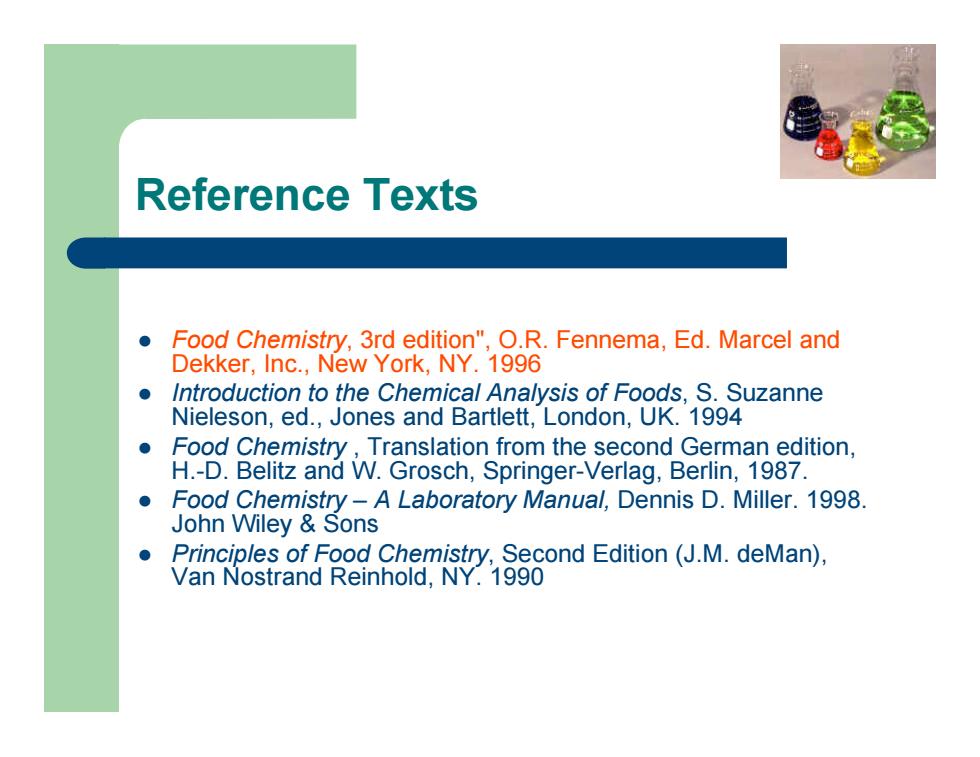
Reference Texts l Food Chemistry, 3rd edition", O.R. Fennema, Ed. Marcel and Dekker, Inc., New York, NY. 1996 l Introduction to the Chemical Analysis of Foods, S. Suzanne Nieleson, ed., Jones and Bartlett, London, UK. 1994 l Food Chemistry , Translation from the second German edition, H.-D. Belitz and W. Grosch, Springer-Verlag, Berlin, 1987. l Food Chemistry – A Laboratory Manual, Dennis D. Miller. 1998. John Wiley & Sons l Principles of Food Chemistry, Second Edition (J.M. deMan), Van Nostrand Reinhold, NY. 1990
Reference Texts l Food Chemistry, 3rd edition", O.R. Fennema, Ed. Marcel and Dekker, Inc., New York, NY. 1996 l Introduction to the Chemical Analysis of Foods, S. Suzanne Nieleson, ed., Jones and Bartlett, London, UK. 1994 l Food Chemistry , Translation from the second German edition, H.-D. Belitz and W. Grosch, Springer-Verlag, Berlin, 1987. l Food Chemistry – A Laboratory Manual, Dennis D. Miller. 1998. John Wiley & Sons l Principles of Food Chemistry, Second Edition (J.M. deMan), Van Nostrand Reinhold, NY. 1990
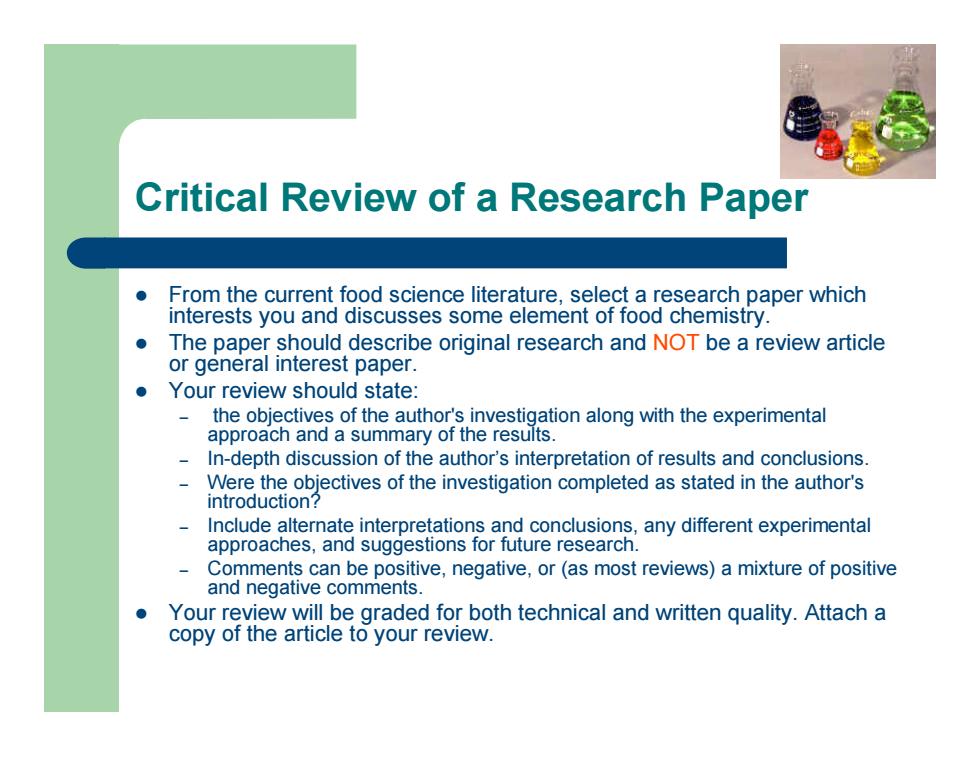
Critical Review of a Research Paper l From the current food science literature, select a research paper which interests you and discusses some element of food chemistry. l The paper should describe original research and NOT be a review article or general interest paper. l Your review should state: – the objectives of the author's investigation along with the experimental approach and a summary of the results. – In-depth discussion of the author’s interpretation of results and conclusions. – Were the objectives of the investigation completed as stated in the author's introduction? – Include alternate interpretations and conclusions, any different experimental approaches, and suggestions for future research. – Comments can be positive, negative, or (as most reviews) a mixture of positive and negative comments. l Your review will be graded for both technical and written quality. Attach a copy of the article to your review
Critical Review of a Research Paper l From the current food science literature, select a research paper which interests you and discusses some element of food chemistry. l The paper should describe original research and NOT be a review article or general interest paper. l Your review should state: – the objectives of the author's investigation along with the experimental approach and a summary of the results. – In-depth discussion of the author’s interpretation of results and conclusions. – Were the objectives of the investigation completed as stated in the author's introduction? – Include alternate interpretations and conclusions, any different experimental approaches, and suggestions for future research. – Comments can be positive, negative, or (as most reviews) a mixture of positive and negative comments. l Your review will be graded for both technical and written quality. Attach a copy of the article to your review

LABORATORY REPORTS l Lab reports will follow the guidelines set by the Journal of Food Science for manuscript preparation. l FULL TITLE - be concise l NAME(S) OF AUTHOR(S) l AUTHOR AFFILIATION(S) - complete address(es) l ABSTRACT - 200 words l INTRODUCTION - state the objectives of your work l MATERIALS & METHODS l RESULTS & DISCUSSION l CONCLUSION - State conclusions (do not summarize) briefly. l REFERENCE(S) – At least 5, including research papers
LABORATORY REPORTS l Lab reports will follow the guidelines set by the Journal of Food Science for manuscript preparation. l FULL TITLE - be concise l NAME(S) OF AUTHOR(S) l AUTHOR AFFILIATION(S) - complete address(es) l ABSTRACT - 200 words l INTRODUCTION - state the objectives of your work l MATERIALS & METHODS l RESULTS & DISCUSSION l CONCLUSION - State conclusions (do not summarize) briefly. l REFERENCE(S) – At least 5, including research papers

T. Y. HWANG1, S. M. Son2, C. Y. Lee2, and K. D. Moon1. (1) Dept. of Food Science & Technology, Kyungpook National Univ., 1370 Sankyuk dong Pukku, Taegu, 702-701, South Korea, (2) Dept. of Food Science & Technology, Cornell Univ., W. North St., NYSAES, Geneva, NY 14456 Unfavorable enzymatic browning occurred in many minimal processing fruits and vegetables. This discoloration is not a chemical quality defect, however, it is not appealing to consumers and thus reduces the market value. The discoloration of minimally processed products has been considered to be caused by the reaction between polyphenol oxidase(ppo) activity and phenolic compounds. A better understanding of the relationship among ppo activity, phenolic contents, and discoloration reaction in minimal processing products would facilitate development of treatments to control the browning for those. Objective was to control browning of fresh-cut potatoes treated with cool and heating acid solutions and to determine ppo activity and total phenolic contents that affect browning of flesh after fresh-cut. Fresh-cut potatoes were treated by dipping for 1.5 min in browning inhibitor solution containing 0.5% ascorbic acid + 0.5% citric acid + 0.5% sodium chloride + 0.1% trehalose + 0.005% biotin at 60oC, cooled for 1.5 min and stored at 4oC. Surface color, ppo activity, total phenolic content and visual sensory attributes of product were measured during storage at 4oC. Our results showed that ppo activity and the flesh browning were increased during storage. The delta L values clearly indicated that the cool solution treatment was more effective than heating, delaying discoloration for at least 7 days. Total phenolic content of fresh-cut potato was decreased except for potato with heating solution treatment. The cool solution treatment was significant (p<0.05) for visual sensory attributes, hunter value, total phenolic content and ppo activity. The heating water was effective for antibrowning than the heating solution after 7 days. These results suggest that the solution prevent flesh browning of fresh-cut potatoes because of reducing ppo activity and total phenolic content. The cool solution treatment represents a possible alternative to use of sulfites in controlling discoloration reactions of fresh-cut potatoes. The relationship among flesh browning, polyphenol oxidase activity, and total phenolic contents in minimally processed potato(Solanum tuberosum var. Romano)
T. Y. HWANG1, S. M. Son2, C. Y. Lee2, and K. D. Moon1. (1) Dept. of Food Science & Technology, Kyungpook National Univ., 1370 Sankyuk dong Pukku, Taegu, 702-701, South Korea, (2) Dept. of Food Science & Technology, Cornell Univ., W. North St., NYSAES, Geneva, NY 14456 Unfavorable enzymatic browning occurred in many minimal processing fruits and vegetables. This discoloration is not a chemical quality defect, however, it is not appealing to consumers and thus reduces the market value. The discoloration of minimally processed products has been considered to be caused by the reaction between polyphenol oxidase(ppo) activity and phenolic compounds. A better understanding of the relationship among ppo activity, phenolic contents, and discoloration reaction in minimal processing products would facilitate development of treatments to control the browning for those. Objective was to control browning of fresh-cut potatoes treated with cool and heating acid solutions and to determine ppo activity and total phenolic contents that affect browning of flesh after fresh-cut. Fresh-cut potatoes were treated by dipping for 1.5 min in browning inhibitor solution containing 0.5% ascorbic acid + 0.5% citric acid + 0.5% sodium chloride + 0.1% trehalose + 0.005% biotin at 60oC, cooled for 1.5 min and stored at 4oC. Surface color, ppo activity, total phenolic content and visual sensory attributes of product were measured during storage at 4oC. Our results showed that ppo activity and the flesh browning were increased during storage. The delta L values clearly indicated that the cool solution treatment was more effective than heating, delaying discoloration for at least 7 days. Total phenolic content of fresh-cut potato was decreased except for potato with heating solution treatment. The cool solution treatment was significant (p<0.05) for visual sensory attributes, hunter value, total phenolic content and ppo activity. The heating water was effective for antibrowning than the heating solution after 7 days. These results suggest that the solution prevent flesh browning of fresh-cut potatoes because of reducing ppo activity and total phenolic content. The cool solution treatment represents a possible alternative to use of sulfites in controlling discoloration reactions of fresh-cut potatoes. The relationship among flesh browning, polyphenol oxidase activity, and total phenolic contents in minimally processed potato(Solanum tuberosum var. Romano)